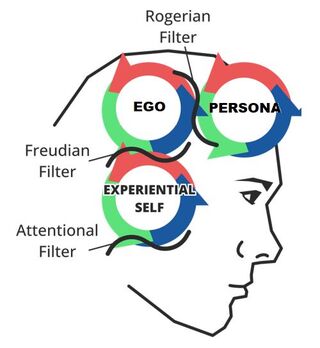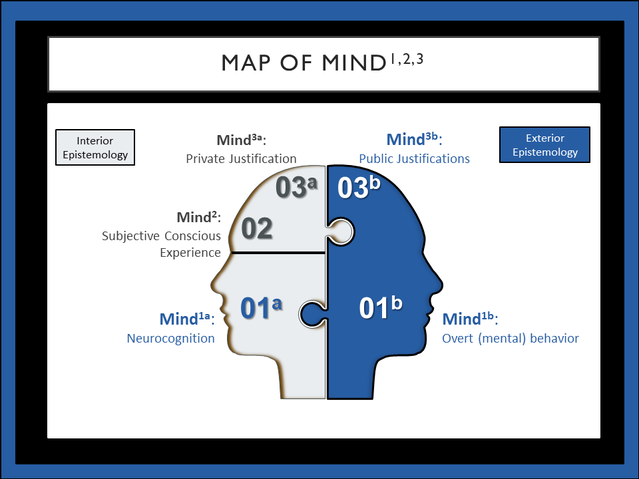Freudian Psychology
The Three Filters of Consciousness
Three filters frame the domains of human consciousness.
Posted March 1, 2022 Reviewed by Abigail Fagan
Key points
- The self, ego, and persona are the three major domains of human consciousness and they are separated by filters.
- The filter between the experiential self and the ego is called the Freudian Filter; it regulates our subconscious drives and feelings.
- The filter between the ego and the persona is called the Rogerian Filter, and it represents how we manage our impressions.
- The filter between basic non or subconscious neurocognitive processes and subjective conscious experiences is called the attentional filter.
In addition to the basic capacity for sense perception, the Unified Theory of Knowledge (UTOK)1 identifies three primary domains of human consciousness. The first is the experiential or primate self, which includes both the capacity for subjective experience and the manner in which perceptions become referenced against motives and emotions that are relevant to one's self. The basic features of this domain of consciousness is shared with other mammals. The second domain is the ego, which refers to the language-based narrating capacity of your interpreter system. It is the “I” that describes, evaluates, and explains the “me” when you are engaged in explicit self-conscious reflection. Finally, your persona refers to the way you project your identity out into the social world to manage impressions and regulate your role and place in the social field.
These domains are specified in UTOK via Justification Systems Theory (JUST)2. In particular, JUST argues that we can understand the evolution of the human ego and persona as arising out of the fact that with propositional language came the problem of having to justify one’s self to others. UTOK proclaims this is a central problem that shapes the structural and functional arrangement of our language-based propositional thought. It also makes very clear predictions regarding the relationship between the domains of consciousness. Specifically, JUST posits that there should be specific kinds of filtering processes that should be present between both the experiential self and the ego and the ego and the persona. These dynamic processes are where we find two of the three filters of consciousness.
According to JUST, the ego must narrate what is happening to the primate experiential self and do so with the task of developing a justifiable narrative of events. This means that there should be filters associated with how the ego construes the experiential self. Specifically, it should work to filter out impulses, images, ideas, and feelings that are unjustifiable. And it should then work to develop justifiable narratives for those experiences, drives, and images that are acknowledged. In addition, powerful thoughts and feelings that the ego cannot control or deny should be experienced as alien and “ego-dystonic.”
Of course, therapists of a psychodynamic orientation have long identified precisely these kinds of processes and dynamic relations between self-consciousness and subconscious processes. Indeed, the idea that the ego sits atop the more animalistic portions of our mental lives and filters out undesirable processes via repression or suppression and then rationalizes those portions to manage our sense of self in the relational world is a basic set of insights from the Freudian tradition. It is because of this set of insights from psychodynamic theory that UTOK labels the filter between the primate-experiential self and the ego the "Freudian Filter." It operates between nonverbal images, drives, and impulses and verbal narration and, at this interface, the primary dynamic this filter is attempting is to translate the experiential self into a justified narrative and also regulate it so that it conforms.

The theory of human consciousness given by JUST posits that humans must manage their place on the social stage. Specifically, people can be at least partly understood as actors on the social stage who are responsible for their role and place and are regulated by the expectations and judgments of others. To be valued and obtain social influence, they must play that role at least adequately, and in a way that is in concert with the expectations and demands of the social network they inhabit.
These dynamics make clear what each of us knows well as human persons: We must regulate the impressions we create on the social stage. And this means that there is a filter between our private ego and self, and the public self we present to others. In its most basic terms we can call this the private to public filter; however, JUST allows us to both be more specific and connect it with another major domain of psychological thought. Carl Rogers made a number of powerful insights into psychopathology when he realized the central dynamic in navigating the judgments and evaluations of others. Specifically, he saw that trying to meet the demands of others set many people up to discount their core self, what he referred to as the core organismic valuing process, and instead block that and conform. Unfortunately, doing so often leaves people feeling empty and alienated and out of contact. Because of these insights from Rogers, UTOK calls the private to public filter "the Rogerian Filter."
The Freudian and Rogerian Filters show how the idea of JUST provides a causal explanatory framework for unifying some of the most important insights from psychodynamic and humanistic thought. The last filter is more basic. It refers to the process by which non or subconscious mental processes become objects of perceptual awareness that we can experience. This problem is explored by cognitive neuroscientists and consciousness researchers. One particularly excellent set of analyses on this issue comes from Dehaene’s (2014)3 work on the global neuronal workspace model of consciousness. His work shows how attention is a central focusing aspect of conscious experience (although not synonymous with it). Indeed, we can think about attentional processes as serving as a kind of filter between sub or nonconscious neurocognitive processes and those that appear in our experiential awareness.
UTOK comes with a map of mental processes that differentiates non or subconscious mental processes from subjective conscious experiences4. This Map of Mind1,2,3 frames neurocognitive functions as Mind1 processes and subjective conscious experiences as Mind2. The attentional filter is the filter that regulates between them. UTOK further labels self-consciousness narrative processes as the domain of Mind3. Some of these processes are private, which, as this blog notes, is called Mind3a. Some are public, which are called Mind3b. We can then see that the Freudian Filter sits between Mind2 (experiential consciousness) and Mind3a, whereas the Rogerian Filter sits between Mind3a and Mind3b.

In sum, UTOK identifies three basic filters in human consciousness. The attentional filter regulates non and subconscious Mind1 processes that might pop into Mind2. The Freudian Filter regulates the relationship between both Mind1 and Mind2 and the ego, which is Mind3a. The Rogerian filter regulates the private Mind3a verbalizations with what is publicly stated (Mind3b) and thus is in the domain of the persona. With its analysis of the filters of human consciousness, its map of the domains of mental processes, and its theory of why human self-consciousness evolved with the structure and functional dynamics it did, UTOK allows us to finally clarify the nature of human consciousness, metaphysically, ontologically, epistemologically, and metatheoretically. That is one of the reasons UTOK is a unified theory of knowledge.
References
1. The Unified Theory Of Knowledge is a new scientific humanistic synthetic philosophy that resolves the mind-body problem and unifies our knowledge from the natural sciences, the social sciences, the humanities, as well as our personal psyches into a coherent picture.
2. For more on Justification Systems Theory, see here.
3. Dehaene, S. (2014). Consciousness and the brain. Penguin Book, NY.
4. Henriques, G. (2020). What are mental processes? Psychology Today blog, Theory of Knowledge (here).


